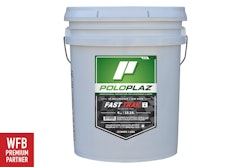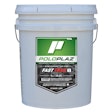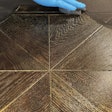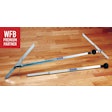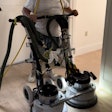The Problem
About a year ago, I was called in to investigate an adhesion complaint: Oil-modified polyurethane (OMU) was lifting off in sheets only three months after being put down under two different sets of circumstances.
The Procedure
An addition and some remodeling were completed on the home, and new 2 1/4-inch quartersawn white oak was installed. The new floor connected with existing 2 1/4-inch white oak floors. The objective was to blend in the new floor with the existing wood floor. The old floor was to be cleaned, screened and recoated, since its existing finish was sound and intact.
The contractor said he applied a single-component waterborne sealer over the natural new wood. After allowing the sealer to dry overnight, it was evident that the new wood did not match the color of the existing floor, but rather showed a definite lighter contrast. The contractor decided to scuff-sand the sealer coat by hand and apply a penetrating stain in an effort to minimize the color variance. The stain was rubbed in by hand and allowed to dry overnight. Then, a first coat of satin OMU was applied over the stain with a 3/8-inch roller and allowed to dry overnight. That coat then was screened with a new 120-grit black mesh screen, and the floor was swept, vacuumed,tacked with mineral spirits and allowed to dry. After the cleaning, a second, final coat of satin OMU was applied.
On the existing floor, the contractor screened the floor with a new 120-grit screen. He swept and vacuumed, then tacked not with mineral spirits, but with a "liquid surface preparation product." According to the product's label, it cleans all dirt, grease and wax from the surface, dulls the old finish, and softens the old finish to provide a "tacky" surface. The product also claims to make it easier to apply the new finish, help the new finish bond better to the treated surface, and prevent chipping after the new finish dries.
After washing the existing floor with this liquid surface prep, the contractor allowed the floor to dry for a few hours. He then applied an OMU sealer,which dried overnight. The following morning, he did not screen the sealer coat, but applied a coat of satin OMU directly on top and allowed that coat to dry overnight. The next day, he screened the satin OMU with a new 120-grit screen, swept, vacuumed and tacked with mineral spirits before applying a final coat of satin OMU.
The Cause
On the new floor, the mistake was applying a penetrating stain over a previously sealed surface. According to the label directions, the stain should be applied directly to properly prepared raw wood that is free of all surface contaminants and old coatings. Applying the stain on top of the sealed floor left a tremendous amount of excess stain on top of the wood, creating a barrier that prevented the satin OMU from bonding with the surface. What was interesting in this case was that where the peeling was removed, you still could see the presence of the waterborne sealer and the lightness of the floor prior to the forced application of the stain.
On the old floor, the contractor neglected to fully read the manufacturer's directions. The label said the new finish bonds to the old finish provided the old finish still is soft and tacky (according to the label, a 30-minute time frame), but the contractor let the application dry for a few hours. He did screen the floor before the solvent wash,but because he waited a few hours, the "liquid sandpaper" negated the screening process and caused the existing finish to re-harden back to its original state. Therefore, the subsequent coats of OMU had nothing to hold onto, which ultimately caused the finish to lift.
How to Fix the Floor
A finishing system is only as strong as the foundation it is built upon. On both floors, the current foundation was not strong, so my recommendation was to sand down to the raw wood. Trying to screen and recoat only would have added more stress, compounding the peeling problem.
In the Future
From a manufacturer's point of view, I cannot stress enough the importance for end users to read and understand pre-printed label directions. If the directions seem vague or you plan to use the product for something other than its intended purpose, a quick 10-minute phone call to the manufacturer's technical service department should answer all your questions. Taking shortcuts by trying to combine certain critical steps can only lead to problems. If there's one thing I have learned in my years or experience, it is that it is a lot easier to explain to a customer why things are right than why they are wrong.














